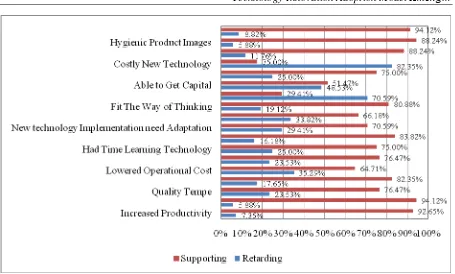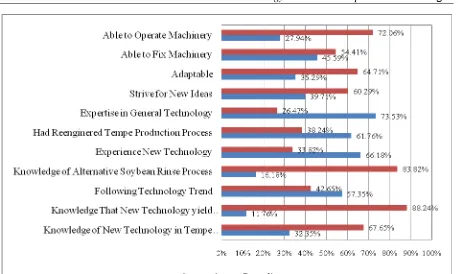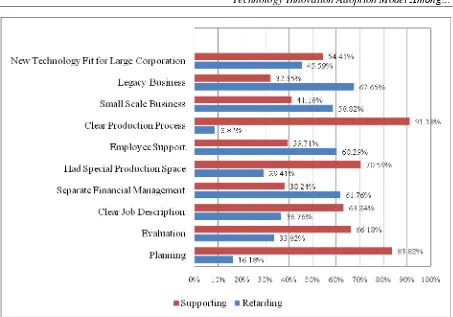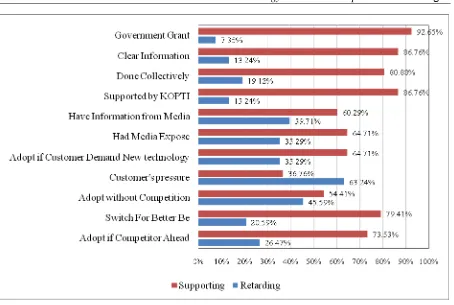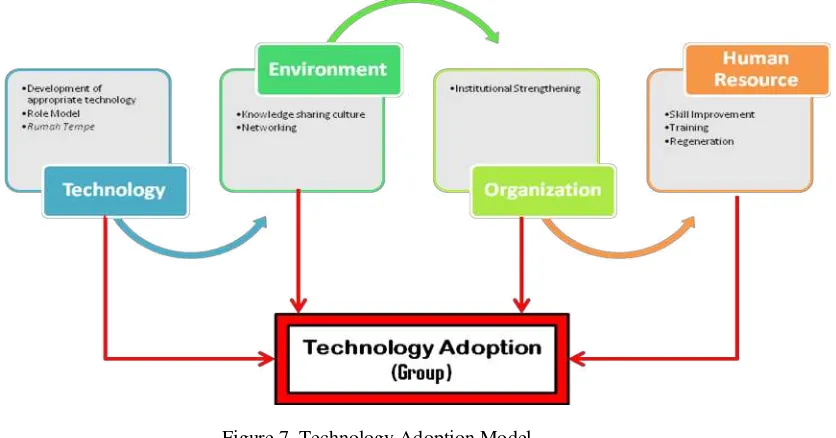www.ijbmi.org Volume 3 Issue 2February. 2014
ǁ
PP.05-14
(Faculty of Business and Economics, Satya Wacana Christian University, Indonesia)
ABSTRACT:
Up till now, Tempe, which is known as typical traditional Indonesian foodstuff, is produced using non standardized low-tech process. Although widely known as highly nutritional and beneficial to health, nevertheless, Tempe is recognized as cheap, non-prestigious meal, and mostly consumed by rural peoples. This circumstance is the result of nearly every Tempe industry being small, home-scale industry practicing traditional low-tech process. This research aim to create a model of adoption of innovative production technology in Tempe industry. The study was conducted on 68 tempe producers whom are members of Koperasi Tahu dan Tempe Indonesia (KOPTI) in the municipality of Salatiga and Boyolali district. The data was collected using combination of several techniques such as FGD (focus group discussion), in depth interview and survey. In terms of technology adoption rate, the results showed the majority of tempe producers are classified as laggards and early adopters. Factors associated with technology and external environmental conditions were found to be motivating factors in the adoption of technology. Further, results of the study also showed a number of factors related to the quality of human resources and organizational readiness become inhibiting factors that quite prominent in the adoption of new technologies among tempe produce .KEYWORDS :
adoption of technology, innovation, Tempe producersI.
INTRODUCTION
Efficacy of a business depend on the ability of itself to apply various technology suited to improve efficiency in its business process and in turn can improve competitiveness. Limited technological application become one of constraint causing small industry cannot go forward and expand in an optimal fashion beside other constraint like the limited capital, lack of expertship and skilled human resources, and also the problem of management ( Hanani, 2003 in Sumarno, 2010). It’s widely known that fundamental problems of low small industrial competitiveness and efficiency in Indonesia lay in the limited application of production technology and management.It is highly important for traditional Tempe industry to adopt innovative production technology to cope with changing environment. Tempe, which used to be known as cheap, non-prestigious meal, and mostly consumed by rural peoples, currently gaining more consumer. This is due to current research that shows Tempe as highly nutritional, have the potential to fight free-radicals, hence delay aging process, and fights degenerative diseases (Aristiarini, 2000). 50% of total soy consumption in Indonesia is in the form of Tempe, 40% in the form of bean curd, and the last 10% in other forms (soy paste, soy sauce, etc.). Tempe mean consumption per people per year in Indonesia this time is anticipated to reach around 6,45Kgs (http://id.wikipedia.org/wiki/Tempe). Other source reveals Indonesia world’s largest Tempe producer, and the
largest soy market in Asia (Ongkokham, 2000).
innovative production technology. Furthermore, a number of other studies found that the decision to determine the choice of technology at small businesses affected by technological factors, individual factors (characteristics of entrepreneurs), the organization resources factors, and environmental factors (situational). The factors mentioned above can be a contributing factor or factors inhibiting the adoption of technology entrepreneurs.The above exposition shows that efforts to produce a variety of new technologies cannot be separated by the fact that the process of technology adoption becomes an important issue in determining the success of the adoption of innovative production technology by small industries. Therefore Tempe processing technology development efforts also need to be done integratively. Among others, the need to understand well the Tempe craftsmen readiness to adopt technological innovations and what factors influence it. Thus there is certain that the effort to create a new technology can be applied at the manufacturer level, so it does not become a wasted activity. With a mind work as has been described above, emerge an interesting issues for be further studied, namely “The Adoption of Technological Innovations in Tempe Producers”. Specifically, the purpose of this study was to:
[1] Measure the rate of adoption of technological innovations in Tempe producers in the municipality of Salatiga and Boyolali district, Central Java.
[2] Identify driving factors and inhibiting factors in the adoption of technological innovations in Tempe producers from the aspects of individual, organizational/ institutional, technological aspects and environmental aspects.
[3] Finding suitable models of adoption of technological innovations in Tempe producers
II.
THEORETICAL
STUDY
2.1. SME (Small and Medium Enterprises)Given the scale of its business, Tempe producer can be categorized as small industry and households. The definition of small industry and households follow the definition of SMEs based on Law no. 20 of 2008
section 6 (http://www.djmbp.esdm.go.id/sijh/UU_2008_20_TENTANG_USAHA_MIKRO_KECIL_DAN
_MENENGAH.pdf). Micro Business is a business entity that has a maximum net worth Rp. 50,000,000.00 (fifty million Rupiahs), not including land and buildings, or having an annual sales turnover of Rp. 300,000,000.00 (three hundred million Rupiahs). Small Business is a business entity that has a net worth of more than Rp. 50,000,000. 00 (fifty million Rupiahs) up to Rp. 500,000,000. 00 (five hundred million rupiahs) excluding land and buildings, or having annual sales turnover of over Rp. 300,000,000.00 (three hundred million rupiahs) up to Rp. 2,500,000,000.00 (two billion five hundred million dollars).
1.2.Adoption of Technological Innovations
Mardikano (1982, in Mizar et al, 2008) defines adoption as the acceptance or use of the ideas, tools (machines) or by the adopter of new technology delivered by carrier technology. It has been generally accepted that the technology can help organizations improve their performance to further achieve competitive advantage (Adam, 2009; Ellitan, 2003). The positive role of technology in moderating business strategy and business performance result in final increase of the business competitiveness. Diffusion of Innovation Theory or Diffusion of Innovation (DOI) proposed by Rogers in 1983 (Rogers, 2003) is a theoretical framework that is used to understand the evaluation, adoption and implementation of technology, as well as identifying factors - factors that inhibit and encourage the adoption and implementation of technology (Fichman, 1992).Rogers (2003: 14-16) suggests five attributes in the Diffusion of Innovations Theory which determines the adoption of new technologies. The first attribute, Relative advantage indicates the extent to which a technological innovation over previous innovations. These benefits can be seen from the standpoint of technical, economic, prestige, comfort, and satisfaction. If someone feels that the relative advantage of technological innovations provided high then it will adopt the technology.
technical aspects, there are three other things that are not less important. They are the environmental aspects, organizational aspects, and aspects of the individual. Al-Qeisi (2009) mentions the existence of four additional attributes that affect the adoption of technology, namely: 1) the type of technological innovation; 2) the communication channel; 3) social systems, and 4) changes in promotion agency. Based on a review of literature in this study we propose a research model presented in Figure 1 below.
Adoption of
Source: Teo dan Tan, 1998; Thong, 1999; Palvia dan Palvia, 1999; Kuan dan Chau, 2001; Ling, 2001; Scupola, 2003; Rogers, 2003; Filiatrault dan Huy, 2006; Bellaaj dkk, 2008; Mizar dkk, 2008; dan Al-Qeisi, 2009 (Modified for research purpose).
1.3.Adoption of Technological Innovations Rate
Rogers (2003: 22) states that based on individual characteristics such as socio-economic conditions, interaction and communication behavior, adoption of an innovation can be divided into five categories: innovators, early adopters, early majority, late majority, and laggards. Rogers (2003) describes the behavior of the adoption of new innovations form a normal distribution curve as shown in Figure 2 below.
Figure 2. Categorization Level of Innovation Technology Adoption Source: Roger (1995: 281)
who are willing to make an initial investment to a new technological innovation, considering the level of security on respective investment. Late majority are people who are skeptical of the benefits of new technological innovation, but it will eventually adopt new innovations on condition such as almost all members of the group adopt or pressure needs to adopt new innovations. Laggards are a group of individuals who are most slow to adopt new innovations. They tend to be suspicious of the benefits of new innovations and refused to adopt it.
III.
RESEARCH
METHODOLOGY
Objects in this study were Tempe producers in the municipality of Salatiga and Boyolali districts that are members of KOPTI (Cooperative Tahu Tempe Indonesia). Respondents in this study were Tempe producers in the municipality of Salatiga and Boyolali and Management of Primkopti Central Java Province. Respondents are selected using saturation sampling. The number of respondents who populate the data completely numbered 68 people.The data used to indicate determinants of technology adoption from aspects of human resources (HR), organization, technology, and environment. HR aspect consists of the knowledge, attitudes that lead to innovation, and the entrepreneurial spirit. Aspects of the organization consist of the type and scale of the organization, work attitude, product characteristics, quality and type of innovation, management support, asset, and communication connectivity. The technology aspect / innovations include relative advantage, complexity, compatibility, cost, and image. While the environmental aspects include competitive pressures, pressure suppliers and buyers, media pressure, public policy, and government support. Data collection is done through respondent’s survey and focus group discussion. Data are processed using descriptive statistics.General characteristics of the respondents surveyed consisted of 44% men and 56% women. The majority of respondents aged between 30-40 years (50%), the majority of primary school education (72%), approximately 63% of the respondents rely on Tempe as their principal occupation, while the rest do it as side job where their principal occupation is farming. Over half of all respondents (52%) set up their own Tempe business, while the rest (48.5%) inherited the business from their parents. Almost all respondents involved or supported by family labor / family.
IV.
RESULTS
AND
DISCUSSION
4.1. Supporting and Retarding Factors in Technology Adoption Within SME Tempe Producer Technological Aspect
From Figure 3 it can be concluded that all the attributes of empirical indicators, namely, relative advantage, complexity, compatibility, and technology aspects become driving factors for Primkopti members Tempe producers in Salatiga and Boyolali to adopt new technologies. This is reflected by more than 50% of respondents percept positively to the above mentioned empirical indicators used to measure these attributes. As for retarding factors in adopting new technology for the Primkopti members Tempe producers in Salatiga and Boyolali are attributes that include the cost of initial capital availability and high cost of implementation of new technologies.
Figure 3. Aspects of the Technology Factors to be considered Source: Primary Data, Processed, 2013
The second attribute in the aspects of technology that is also a key driver in the adoption of new technology is a benefit of the new technology itself (relative advantage), with an average score of 4.09. More than 90% Tempe producers who responded stated that the use of new technology will improve the efficiency of the production system so that production time and Tempe production process can be shortened with the same product quality or even better. This will lead to increase of Tempe producer’s productivity.Technology aspects attributes in the technology adoption process that considered retarding by Primkopti members Tempe producers in Salatiga and Boyolali is cost (average score of 3.32). The majority of producers (82.35%) perceived that the high costs required implementing the new technology. More than 70% stated they did not have the sufficient capital to implement new technologies even though they are aware that these technologies will improve the competitiveness of their businesses. From these results we conclude that cost attribute the of the technology aspect becomes a major retarding factor for Primkopti members Tempe producers in Salatiga and Boyolali to adopt new technologies in their Tempe producing process.
Aspects of the Human Resources (HR)
Figure 4. Aspects of human factors to be considered Source: Primary Data, Processed, 2013
Human factors that need attention in order to encourage the adoption of technology in the production process are related to each other. Tempe producers in Salatiga and Boyolali municipality do not continually follow the information regarding development of the Tempe production process technology, so that the majority of respondents never make changes in their production process, this condition is also shown by the majority of respondents who do not have the experience of seeing technology for new Tempe production processes and have experience in the field of technologies in general. These condition mostly caused by producers already have Tempe business for generations, have a small-scale enterprises, and the limited ability of employees in improving and maintaining the equipment/ machine technology.
Organizational Aspects
Gambar Figure 4. Aspects of Organizational Factors to be Considered Source: Primary Data, Processed, 2013
Organizational factors that need to be considered because it can hinder the adoption of production process technology are the business scale, family inherited business, support staff, and clear financial management. Almost all Tempe producers scale is in the micro and small scale. The funding limitation was also a reason for not doing financial management properly that lead to limited working capital, making it difficult for them to have competent employees (because the salary should be given relatively high). In fact all respondents admitted working on his own and family member. Even if there are hiring outsiders, usually there are still families tied.Overall, the organizational aspects as described above are expected to be a factor that can hinder the adoption of technological innovations in Tempe production. Influence by local culture for a vastly diverse foods that can be made from Tempe also reinforcing the slow adoption of technology in organizational aspects. Every step from young Tempe (unfermented) to the rotten Tempe can be used as local specialties. Tempe producer do not care to consider innovation, because they think their products will still be sold and never wasted.
Environmental Aspects
Figure 5. Aspects Considered in the Environmental Factors Source: Primary Data, Processed, 2013
The factors that stand out as either supporting or retarding technology adoption. It is thought to be related to the small scale of respondent’s business, as well as most of the Tempe producers only had elementary education, with an average middle age (> 40 years), therefore, majority of Tempe producer are more oriented to production (production centered) and not many customer-oriented. Thus they are less sensitive to the demands from consumers and the media. As with the competition, the desire to outperform competitors found to be contributory factors for Tempe producers to adopt new technologies
1.4.Level of Technology Adoption
Figure 6. Technology Adoption Level of Primkopti Member Tempe Producer in Salatiga and Boyolali Source: Primary Data, Processed, 2013
Innovator and early adopter groups reflects that the Primkopti members Tempe producer in Salatiga and Boyolali actually have sufficient awareness of the importance of the application of new technologies to improve their competitiveness in Tempe production. The high quantity laggards adopter group encountered in this study may be related to the age level of the Primkopti members Tempe producer in Salatiga and Boyolali. The majority of respondents in this study aged 45 years and over who can be classified as the baby boomers born between the years 1943 to 1960 (http://www.ttuhsc.edu/sah/cls/ GenerationalDifferences .Pdf). This generation tends to be very slow in adopting new technologies because they implement step by step starting from the observation to the implementation stage. The implementation will be done if they are so convinced of the benefits and losses arising from the adoption of new technologies (Hendryx, 2008). This finding is in line with the results of the study of Elias et al (2012) which states that age will moderate the behavior of acceptance of new technologies. Elias et al (2012) concluded that older age (baby boomers versus Generation X); baby boomers tend to be weaker in the acceptance and use of technology
1.5.Technology Innovation Adoption Model
The above findings indicate that the adoption of technological innovations on the MSE Tempe producer can be done gradually with team approach for every Tempe producer. The conditions of Tempe producer in the Municipality of Salatiga and Boyolali district and the rate of adoption of technology were established as model of technological innovations adoption that can be done. Technological aspects strengthening firstly done with Tempe producer who are still in the category of laggards. Knowledge and experience which they see and feel can shift their perspective to the acceptance of the technology. Strengthening the technological aspects can be done with the development of appropriate technologies, role model, and the establishment of the Rumah Tempe. Conducive environmental factors also strengthening the technological aspects into more sustainable. To create a conducive environment factors, Rumah Tempe have been formed to disseminate information and the knowledge of technological innovations adoption. In addition, building a network to encourage the creation of a conducive environment.
Figure 7. Technology Adoption Model Source: Primary Data, Processed, 2013
Enabling conducive environment facilitate the development of the organization that allows the technological innovations adoption to be carried out. Institutional strengthening through Tempe producer groups with KOPTI as mediator can be good to disseminate information regarding technology innovation adoption. For HR aspects, the main focus is on improving skills and training related to the technological innovations adoption and the development and regeneration of Tempe producer to be able to accept the technological innovations adoption optimally.
V.
CONCLUSIONS
AND
FUTURE
RESEARCH
to adopt new production technologies. However, the attributes of the technology aspects, in addition to the cost factor, which is found to be the dominant factor becomes the driving factor is the image attributes and relative advantage.The retarding factors in the technology adoption are found on aspects of human resources and organizational aspects. For HR aspects, limited experience and technological capabilities on manufacturers and workers are recognized as a barrier for technology adoption by Tempe producer. From the aspect of the organization, business hereditary characteristics, small-scale enterprises as well as simple management application that is found to be a factor that does not encourage the adoption of technology in Tempe producer. Related to the rate of adoption, more respondents belonging to the group laggards followed by early adopters. In order for the technology adoption process among Tempe producer can run according to technology adoption models, it is necessary to prepare and improve the quality of human resources and the Tempe business organizations as a contributing factor. In addition, the dissemination of information regarding the development of new technologies need to be intensified for the small business community through more activities such as education by involving KOPTI.Future research may be focused more specifically on the efforts and the dissemination of new technology for small business effectively. Considering cost of new technology adoption recognized as the constraints of technology adoption, it is necessary to find an alternative form of adoption in accordance with the conditions of small businesses, for example by applying a system of collective adoption. All of this can be an interesting and useful topic of future research.
REFERENCES
[1] Adam, Maryam, Pengaruh Tingkat Penyerapan Adopsi Teknologi serta Pendapatan Petani Padi Sawah Pasang Surut di Kabupaten
Indragiri Hilir dan Siak.,Teroka Journal, IX(2), 2009, 181–190.
[2] Al-Qeisi, Kholoid I, Analyzing the Use of UTAUT Model in Explaining an Online Behaviour: Internet Banking Adoption, Doctoral of Philosophy Dissertation, Brunel University, Department of Marketing and Branding, 2009.
[3] Aristiarini, Agnes, Mukjizat Tempe Untuk Kesejahteraan, Kompas, 1 Januari 2000.
[4] Bellaaj, M, Bernard, P, Pecquet, P & Plaisent, M., Organisational, Environmental, and Technological Factors relating to
Benefits of Website Adoption,International Journal of Global Business, 1(1), 2008, 44-64.
[5] Elias, S.M., Smith, W.L., and Barney, C.E, Age as a moderator of attitude towards technology in the workplace: work motivation
and overall job satisfaction, Behaviour & Information Technology, 3(5), 2012, 453-467.
[6] Djmbp.esdm.go.id., Undang–Undang RI tentang Usaha Kecil dan Menengah,
http://www.djmbp.esdm.go.id/sijh/UU_2008_20_TENTANG_USAHA_MIKRO_KECIL_DAN_MENENGAH.pdf, 2008, Retrived 24 November 2011.
[7] Ellitan, Lena, Peran Sumber Daya dalam MeningkatkanPengaruh Teknologi terhadap Produktivitas, Jurnal
Manajemen&Kewirausahaan, 5(2), 2003, 155 – 170.
[8] Fichman, R.G., Information Technology Diffusion: A Review of Empirical Research, Proceedings of the International
Conference on Information Systems, EDIT 13, 1992, 195-205.
[9] Filiatrault, Pierre & Huy, Le Van, The Adoption of E-commerce in SMEs in Vietnam: A Study of Users and Prospectors.
http://info.hktdc.com/alert/eu0013b.htm, 2006, Retrieved November 24, 2011.
[10] Hendryx, J.L., Generational Differences in Learner Attitudes Toward Technology in Education at the University of
Wisconsin-Stout, http://www2.uwstout.edu /content/lib/thesis/2008/2008 hendryxj.pdf, 2008, Retrived September 15, 2013.
[11] Hidayat, Sukardi dan Nurul Insani, Analisis perbandingan pembuatan tempe, Laporan Penelitian, Universitas Brawijaya, Jurusan Teknologi Industri Pertanian, http://ptp2007.wordpress.com/2007/08/31/. 2004, Retrieved January 20, 2012.
[12] Kuan, K.K. dan Chau, P.Y., A perception-based model for EDI adoption in small businesses using a
technology-organization-environment framework, Information & Management, Vol. 38, 2001, 507-521.
[13] Ling, C. Y. Model of Factors Influences on Electronic Commerce Aadoption and Diffusion in Small & Medium sized
Eenterprises, ECIS Doctoral Consortium, AIS region 2 (Europe, Africa, Middle-East), 24-26 June 2001.
[14] Mizar, A., Mawardi, M Maksum, M and Rahardjo B., Tipologi dan Karakteristik Adopsi Teknologi pada Industri Kecil Pengolah Hasil Pertanian.Prosiding Seminar Nasional Teknik Pertanian 2008, Yogyakarta, 18-19 November 2008.
[15] Ongkokham, Tempe: Sumbangan Jawa untuk Dunia, Kompas, 1 Januari 2000.
[16] Palvia, P.C., dan Palvia, S., An Examination of the IT Satisfaction of Small-Business Users, Information & Management, 35, 1999, 127-137.
[17] Rogers, Everett M, Diffusion of Innovations, 5th ed (A Division of Macmillan Publishing Co Inc, New York: Free Press, 2003).
[18] Scupola, Ada, The Adoption of Internet Commerce by SMEs in the South Italy: an Environmental, Technological and
Organizational Perspective,Journal of Global Information Technology Management, 6(1), 2003, 52–71.
[19] Scupola, Ada, Leadership Styles in Ecommerce Adoption, Roskilde university, Department of Social Sciences, Denmark, 2003. [20] Sudarno and Rietveld, Adopsi inovasi pada industri kecil, Prisma, 4(April), 1987, 57– 66.
[21] Sumarno, Muhammad, Tingkat Adopsi Inovasi Teknologi Pengusaha Sentra Industri Kecil Kerajinan Gerabah Kasongan
Kabupaten Bantul,Jurnal Manajemen dan Kewirausahaan, 12(1), 2010, 1-10.
[22] Teo, T. S. H., and Tan, M., An Empirical Study of Adopters and Non-Adopters of the Internet in Singapore,Information &

